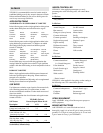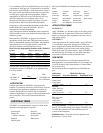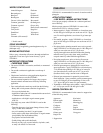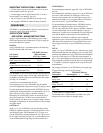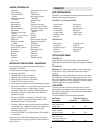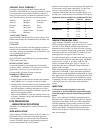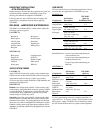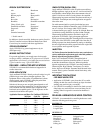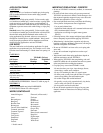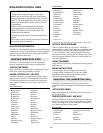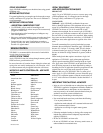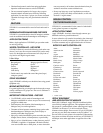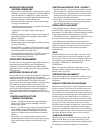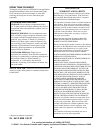
• Weed and brush control results from spring applications
depend on sufficient moisture to activate VELPAR L.
• Do not cut treated vegetation for forage or hay nor graze
domestic animals on treated areas for 60 days following
application. For rates above 3 gal per acre, do not cut treated
vegetation for forage or hay nor graze domestic animals for
1 year.
VELPAR L is recommended for control of brush and weeds in
pasture.
BERMUDAGRASS/BAHIAGRASS PASTURES
VELPAR L is recommended for control of smutgrass and other
weeds in established stands of bermudagrass and bahiagrass.
APPLICATION TIMING
Make a single application of VELPAR L per year when weeds
are actively growing.
WEEDS CONTROLLED - USE RATES
VELPAR L effectively controls the following weeds at the rates
shown. Use a lower rate on coarse-textured soils (sand to sandy
loam). Use the higher rate on fine-textured soils (clay loam to
clay) and on soils high in organic matter.
2 3/4–4 1/2 pt
* Partial control may result with some of the giant (larger)
smutgrass species.
SPRAY EQUIPMENT
Apply VELPAR L uniformly over the desired area using ground
equipment only.
MIXING INSTRUCTIONS
For ground application, use enough water for thorough coverage
usually a minimum of 25 gal per acre. The use of a surfactant is
not recommended.
IMPORTANT PRECAUTIONS - PASTURE
• Use VELPAR L only in stands of bermudagrass and
bahiagrass established for at least one year. Do not treat newly
sprigged or sodded areas.
• Some temporary discoloration of the bermudagrass or
bahiagrass may occur after application.
• Treatment of mixed pastures containing forage species other
than bermudagrass or bahiagrass may result in injury or
mortality to the other forage species.
• Injury may result when desirable grasses are under stress from
drought, insects, disease, cold temperature, or poor fertility.
• Injury to or loss of desirable trees or other plants may result if
VELPAR L is applied or if equipment is drained or flushed
on or near desirable trees or other plants, on areas where their
roots may extend, or in locations where the chemical may be
washed or moved into contact with their roots.
• Severe crop injury may occur if applications are made on
gravelly or rocky soils, thinly covered subsoils, or soils with
less than 1% organic matter.
VELPAR L is recommended for the control of undesirable
woody plants in pasture or rangeland.
APPLICATION TIMING
Apply VELPAR L from late winter through summer, pre-
budbreak until new growth hardens off.
In areas where the soil remains frozen during the winter and
spring rains are usually inadequate for soil activation, a fall
or winter treatment may be applied before the soil freezes.
WOODY PLANTS CONTROLLED
* Partial control.
SPRAY EQUIPMENT
AND APPLICATION TECHNIQUES
Basal (Soil) Undiluted - Apply VELPAR L undiluted with an
exact-delivery handgun applicator. This equipment delivers a
thin stream of a predetermined volume when triggered. Apply
VELPAR L at the rate of 2–4 ml for each inch of stem
diameter at breast height. Do not exceed 1/3 gal of VELPAR L
per acre per year. Direct the treatment to the soil within 3” of
the root collar of woody plants to be controlled. When treating
large stems and when more than one delivery of VELPAR L is
needed per stem, make applications on opposite sides of the
stem.
Alder
American elm
Ash
Aspen
Balsam poplar
Birch
Black cherry
Blackgum
Catclaw acacia
Chinaberry*
Chinese elm
Chinese tallow
Deerbrush
Dogwood
Eastern red cedar*
Hackberry
Hawthorne
Hazel
Hickory
Huisache
Juniper
Locust
Lotebush
Manzanita
Mesquite
Mulberry
Multiflora rose
Myrtle Oaks
Osage orange
Persimmon
Privet
Red maple
Sassafras*
Small soapweed
Snowbrush
Sourwood
Sumac
Sweet bay
Sweet gum
Whitebrush
Whitehorn
Wild plum
Willow
Yellow poplar
BRUSH CONTROL
PASTURE/RANGELAND
Barnyardgrass
Dogfennel
Fescue
Lespedeza
Little barley
Maypop (passion flower)
Oxalis
Pepperweed
Pigweed
Smutgrass*
PASTURE
16



